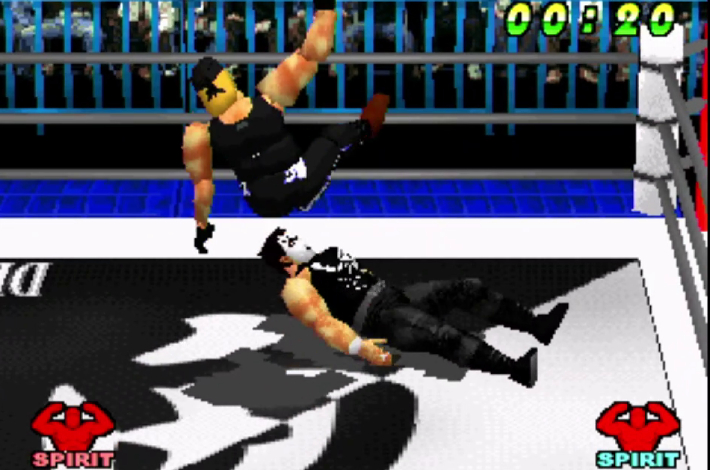When people talk about wrestling games on the original PlayStation, they usually think of the WWF SmackDown! series. But years earlier, before THQ and Yukes redefined the genre, another game set the stage. That game was WCW vs The World.
Released in 1997, this title is often overlooked. Many dismissed it as clunky and outdated. Yet behind the blocky graphics was a system that introduced Japanese wrestling mechanics to a wider audience. It became a stepping stone for the legendary No Mercy and SmackDown! era.
@briangamesdontsuck WCW vs The World for the PlayStation 1. While the Nintendo 64 was tearing it up with its own wrestling games, this was released for the PS1 in 1997. Not quite the wrestling hidden gem game but does not get its praise often either. This was actually made by AKI – the same developer as the infamous NWO World Tour, WCW/nWo Revenge, WrestleMania 2000 and WWF No Mercy games for the Nintendo 64. So you know it's good. #gaming #playstation1 #wrestling #wrestlinggame #hulkhogan #sting ♬ original sound – GamesDontSuck
A Brief History
WCW vs The World came from Asmik Ace Entertainment and AKI Corporation, the studio later known for WCW/nWo Revenge and WWF No Mercy. THQ published the game, marking one of WCW’s earliest entries on the PlayStation.
At the time, wrestling games were still in flux. WWF fans had War Zone from Acclaim. WCW needed its own identity. The twist? This was not a game built from scratch. It was based on a Japanese title, Toukon Retsuden. That explains the slower, methodical gameplay that felt very different from Western brawlers.
Gameplay: A Different Beast
Compared to SmackDown!’s fast button-mashing, WCW vs The World played with patience.
The grappling system asked you to think. Light grapples and strikes came first. Only after wearing down your opponent could you land bigger suplexes or finishers. This mirrored the flow of Japanese puroresu matches, which built drama step by step.
Other gameplay details worth noting:
- Momentum matters – Big moves required momentum, so you couldn’t spam finishers.
- Timing over luck – Reversals came from precise timing instead of random button mashing.
- Authentic pacing – Matches felt more like wrestling, not just fighting games with ropes.
Looking back, it’s clear this game planted the seeds for Revenge and No Mercy.
The Roster: WCW Meets Japan
The roster was a highlight.
The game featured over 50 wrestlers, mixing WCW stars with Japanese counterparts. Many names were altered for licensing, but fans could tell who they represented.
- WCW Stars: Ric Flair, Sting, Lex Luger, The Giant (Big Show), Chris Benoit, Eddie Guerrero, Dean Malenko.
- Japanese Influences: Versions of Antonio Inoki, Keiji Mutoh, Kenta Kobashi, Mitsuharu Misawa, and more.
For many Western fans, this was the first glimpse at Japanese wrestling legends. Even with altered names, the game quietly introduced a global wrestling scene.
Graphics & Presentation
By 1997 standards, the graphics were rough. Wrestlers looked blocky, animations stiff, and arenas simple. They resembled plastic action figures more than real athletes.
Still, the game shined in other ways. Movesets were deep. Wrestlers had unique animations that matched their real-life counterparts. Presentation was basic, but gameplay gave each wrestler an identity.
Game Modes
WCW vs The World offered several modes:
- Exhibition – Standard one-on-one matches.
- Tournament – Battle for fictional championship belts.
- League Mode – A round-robin system, inspired by NJPW’s G1 Climax.
- Ranking Mode – Work through opponents to climb the ranks.
League Mode stood out. It reflected Japanese wrestling culture and was unusual for Western fans.
Reception at the Time
Reviews were mixed.
Some critics praised the grappling system and strategy. Others complained that it felt slow compared to WWF War Zone.
- IGN (1997): Called it “innovative, but clunky.”
- GamePro: Enjoyed the depth, but disliked the simple presentation.
Hardcore fans appreciated the game. Casual players often bounced off.
Legacy: Why It Matters
So why care about a game over 25 years old? Because it was the blueprint.
Without it, we would not have:
- WCW/nWo Revenge
- WWF WrestleMania 2000
- WWF No Mercy
All of these classics evolved from the formula tested here. WCW vs The World proved Western audiences could handle slower, strategy-based wrestling games.
Why It Still Holds Up
Should you play it today? Yes — if you love wrestling game history.
The graphics look dated. The sound is basic. The pacing feels slow compared to modern titles. But if you appreciate the roots of the genre, it’s fascinating. You can see how the mechanics evolved into what many call the golden age of wrestling games.
For hardcore fans, the Japanese roster remains a highlight. It gave Western players a rare look at international wrestling stars, even if under fake names.
Final Thoughts
WCW vs The World may never top a “best wrestling game” list. But it deserves credit as the bold experiment that came first.
It was rough. It was clunky. It frustrated casual players.
Yet it also shaped the games that followed. Without it, we may not have Revenge or No Mercy.
The next time you look back at wrestling’s digital history, remember this game. Before the polished classics, there was a scrappy PlayStation title that dared to be different. That was WCW vs The World.
Buy WCW vs The World for the PlayStation 1 on eBay
Copies of WCW vs The World are quite cheap. Check out some eBay listings below:

